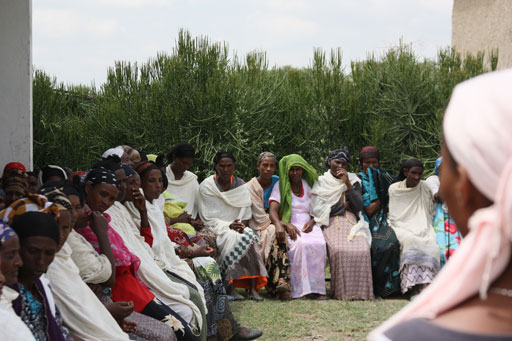4.1 What are stakeholders?
Part of the job of an urban WASH worker involves mobilising local resources to improve the water supply and sanitation situation in your community. This means helping to develop partnerships and collaborations among the stakeholders, for example, by gathering them together at a meeting, as shown in Figure 4.1. But who are the stakeholders and how do you identify them?

A stakeholder is any person, organisation or group with an interest (stake) in something, such as a particular situation, intervention, project or programme. The stakeholders depend on the type and scale of the project, the local context, the local institutional set-up and the cultural conditions.
If you are considering a specific project and wish to identify the stakeholders involved (Mathur et al., 2007), you should consider those who:
- are responsible for the project and its different components (including funders, WASH officials from different sector offices, managers, employees, etc.)
- are intended users or beneficiaries
- are negatively affected by the project but may not be in a position to say so
- might threaten the success of the project through their opposition or lack of cooperation
- could represent the interests of people unable to participate
- have unique knowledge related to an aspect of the project.
Think of an urban WASH project you know about. Try to identify those who might have been involved throughout the planning and implementation process. Can you identify their stake in the project?
The stakeholders will vary from one project to another and you will have your own answer but you may have identified examples from several of the categories above, including representatives of project donors, utilities, contractors, schools, health facilities, local government offices, businesses and householders.
You may also have identified stakeholders who are not visible in direct implementation, but should be taken into consideration. For example, people from neighbouring villages and visitors to the area may wish to use facilities when they become available. Each of these groups have an interest in facilities being developed and hence a stake in the project.
Some of those among the wide group of possible stakeholders can be identified as key stakeholders. A key stakeholder is a person or a group of people with significant influence over a programme or who will be significantly impacted by it. For the programme to be successful, their interests and influences must be recognised. Key stakeholders may include individuals, organisations and businesses in the public, private and non-profit sectors. These could be local community representatives, municipal sector offices (for example, water resources, health and education) and development partners including donors, non-governmental organisations (NGOs), community-based organisations (CBOs) and private sector groups.
Sometimes, new stakeholders may emerge during the lifetime of a project. For instance, community water supply points may be used by people from adjacent villages who had not been considered during initial planning. This can lead to conflicts between intended and unintended users. If such a stakeholder was not involved during the planning stage, then conflicts are likely to be more serious and require resolution. It is much better to try to identify any unintended users at an early stage as this will enable them to feel some sense of ownership and reduce the likelihood of future conflict.
Learning Outcomes for Study Session 4
